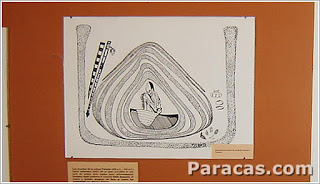Paracas necropolis
Necropolis Paracas culture has an age ranging from 200 BC until the early A.D. The main area of development of this stage was between the Pisco river, the gorge of Topará and the Paracas Peninsula.
This period is characterized by the rectangular shape of its cemeteries, where dozens of mummies entered buried a few meters.
There are indications of the existence of social categories in these burials, as the most powerful characters were highly decorated.
Despite being the most advanced materials such as ceramics achievements they are not as perfect as that of the time of Paracas Caverns.
FunerariosLos bales mummies found show the ability of the Paracas to bury their dead.
The burials of the Paracas necropolis occur in rows of underground rooms, more advanced than the Paracas Caverns stage constructions and formed large burial chambers. They discovered bales with very rich and varied outfits, where is clearly visible the existence of social classes; some bundles are very complex and have many objects, while others only have the mummy.
Ceramic Paracas necropolis
It is an ovoid pottery (globular flattened), looking like "pumpkin" double short tubular spout-and-bridge.
Ceramic predominant natural motifs: figures of people, animals and fruits.
The painting is monochrome, cream, brown, reddish or white.
The paint was applied in precooking.
The walls of the vessels are thinner and that are best cooked Paracas Cavernas of phase.
Los Mantos de Paracas Necropolis
Fine fabrics of Paracas Necropolis are cotton and camel wool, or mixed material generally consists of a basic cotton fabric on which were embroidered with threads of wool figures of different colors.
Fine fabrics of Paracas necropolis were clothing. In life, the robes worn over the head like a big blanket that hung down her back. You probably were used in life, as there are with clear signs of having been used and to hold patches. At death, these items were part of the funerary equipment or clothing, as in the case of the robes.
Manto Paracas Necropolis culture
What gives fame to the Necropolis Paracas fabrics are especially MANTOS.
It is rectangular, long and wide robes as a blanket (its size, on average reaches 2.50 x 1.30 m) whose base is made of cotton or wool, topped by a polychrome embroidery motifs. The recurring motifs are small and are repeated with different combinations, representing mitilógicos beings and very possibly, geometric motifs
The shades are delicate and harmonious. Experts have counted seven colors that have been achieved up to 190 gradations of color. Colors, mineral and vegetable, have been preserved almost unchanged.
Embroiderers and stitchers invented a point that perfectly mimics the crochet tights. Sometimes the embroidery threads are dotted with gold or silver, for sequins, on grounds made with human hair, hairy bat or vizcacha
They were known techniques brocade, veil and network. as well as the art of tapestry duplex.
The plot of these items has a number of strands of about 400 per square inch.
The actual value of one of these beds was estimated in 1972 at around USD $ 2,000,000.




No hay comentarios:
Publicar un comentario